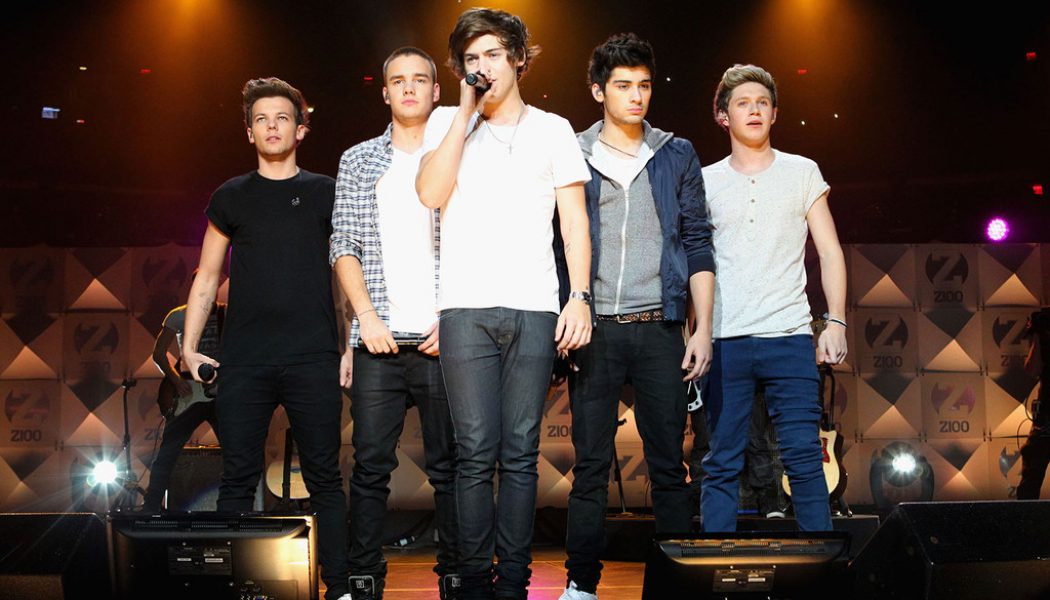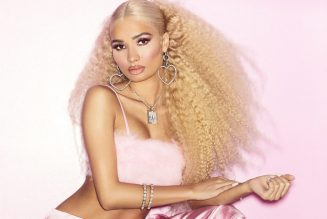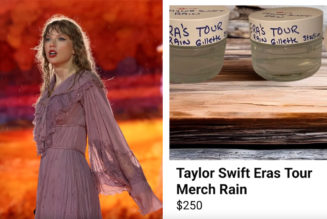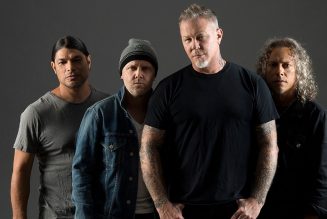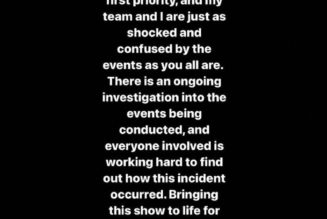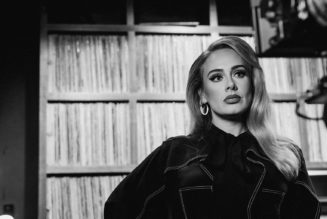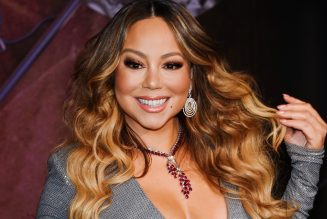
In December 2010, Simon Cowell’s latest boy band endeavor said goodbye to the U.K. The X Factor’s audience had voted the five-piece vocal group into the final three acts on the show’s seventh season, but failed to bring in the numbers that would carry them across the finish line, as singer-songwriter Matt Cardle was ultimately crowned champion. But the group was determined that their elimination wouldn’t mark the end of their story. “We’re definitely going to stay together,” Zayn Malik said. “This isn’t the last of One Direction.”
Malik, Harry Styles, Niall Horan, Louis Tomlinson and Liam Payne, all 16-18 at the time, had each arrived at the popular singing competition’s auditions as solo artists earlier that year, hoping to make it individually. After making it through auditions solo, they were turned down at the conclusion of bootcamp. Not wanting to let them slip away, Cowell called all five guys back on July 23, 2010 and offered them the chance to continue as a group.
The rest is, quite literally, history. Over 300 shows played across four sold out world tours, four No. 1 albums on the Billboard 200, six Billboard Hot 100 top 10 hits, four Video Music Awards, 28 Teen Choice Awards, two Saturday Night Live appearances, billions of streams — and that’s not even considering the solo success each member found, following Malik’s departure in 2015 and the rest of the group’s official hiatus in 2016. This was all made possible by the group’s fervent international fanbase, characterized by its rabid devotion and accelerated by the rise of social media and music streaming, ultimately rivaling the fandom of any other boy band in history.
As we approach the ten year anniversary of One Direction’s formation — with a new anniversary-celebrating 1D website launching next Thursday — Billboard is revisiting the groundbreaking career of one of the most successful boy bands in history, helped by the memories of the die-hard fans who were there for it all.
[embedded content]
The Early Years
One Direction spent each week of its X Factor stint perfecting its harmony as a group, while also building and connecting with a loyal fan base that would be ready and willing to support them when their on-screen journey came to an end. Video diaries uploaded during and after the show gave fans a glimpse into the off-stage personalities of the English-Irish boys they were spending hours cheering on. “They were such ‘normal’ lads, the type of guys you’d go to school with,” says Rhiannon Johnston, 22, who used to spend all of her pocket money voting for One Direction on X Factor. At the time, it cost around 33 pence to vote via phone.
The end of X Factor was just the beginning for the guys, with their efforts at building a sustainable fanbase quickly being validated by their popularity spreading like wildfire among a demographic of immensely dedicated young women. “[Becoming a fan] was almost like a pyramid scheme in the way that one girl would infiltrate your school and attach you to the fandom, and then you would attach people, too,” says Grace McGinnis, 21. (It only took one search for “One Direction Funny Moments” on YouTube for McGinnis to get hooked.)
[embedded content]
The group’s debut album Up All Night was released in the U.K. and Ireland in November 2011, quickly becoming the fastest selling album in the U.K. that year. “What Makes You Beautiful” and “Gotta Be You” were the only two singles released at that point, but they were already more than enough to make 1D an international phenomenon. When Up All Night finally arrived in the U.S. in March 2012, it debuted at number one on the Billboard 200 with over 170,000 copies in its first week.
That same month, thousands of fans shrieked as One Direction rode into New York’s Rockefeller Plaza on a bus adorning the group’s name for its first U.S. television appearance on The Today Show. “What Makes You Beautiful” had only reached the U.S. a few weeks prior and wasn’t a hit yet. “You couldn’t even hear them. There were so many people screaming,” New York-native Hannah Zwick, 20, says of being in the plaza that day. “I had never experienced something like that before.”
[embedded content]
The Peak Years
From 2012 through 2014 were the golden years of One Direction. Their world tours were getting bigger, rising to stadium levels, giving more fans an opportunity to see them live. There was endless content in the form of documentaries, books, albums, award show performances, perfume launches, photoshoots and more. Online, fans shared inside jokes about the guys’ tweets and ridiculous rumors that often sprouted up. “The whole fandom felt like something to be a part of during that time in your youth where you felt out of place,” Kaylan Anderson, 20, says.
For nearly every show of the Up All Night tour, fans logged on to live tweet the grainy live streams they watched together. In one of the first memorable “you had to be there” moments for the fandom, they realized in unison the magnitude of success 1D had reached as the group performed “What Makes You Beautiful” at the 2012 Olympics closing ceremony. After sophomore album Take Me Home (2012) leaked online — as every future album would, too — fans still purchased copy after copy and pretended they’d never heard it before on its actual release date. “When their albums or even just 30 seconds of an unreleased song would leak, everyone around you would forcibly lose their minds,” Victoria Kleinau, 21, says. “It actually made everyone even more excited to have it physically or digitally.”
By then, the update accounts who kept constant tabs on them were struggling to weather the intensity of the fandom. “We wouldn’t release locations [of the group’s members] if we knew they were still there. We didn’t want to cause a mob,” says Caty Dwyer, 27, who ran an account with four other fans. “One time we got a DM that said, ‘I hacked Louis’ British Airways rewards number and I can track his flight now.’ And we were like, what? That’s creepy.” Although it wasn’t the majority, the invasiveness of some fans — and the insistent belief of “Larry Stylinson” stans who were convinced Tomlinson and Styles were in a secret relationship with each other — put a strain on the group’s relationship with fans at times.
“Looking back from the perspective of the age they were, it definitely was crossing a serious boundary,” Lexi Lane, 20, says. “Even Beatlemania or *NSYNC never had those levels [of invasiveness], and I think technology and fan access to it played a heavy role.”
[embedded content]
Fans were generally stanning in unison with each other, though. When the music video for “Best Song Ever” was released, launching the Midnight Memories (2013) album era, fans streamed it nonstop on multiple devices to break the Vevo record for most views in 24 hours with 12.3 million views. (The single debuted at No.2 on the Billboard Hot 100, becoming their biggest hit to date.) That era also came with One Direction hosting 1D Day — a live stream that had fans glued to their screens all day, no questions asked. “Before it started, I gathered all of the food I could get and spent eight hours in bed literally just watching them goof around,” Lucy Bottari, 20, says.
Also released in 2013, the full-length behind-the-scenes documentary This Is Us shed light on the hectic life of the world’s biggest boy band. “It really showed a deeper side of the band,” Lexi Lane says. “I remember a lot of the pranks behind the scenes at their shows or just them riding around being goofy on scooters.” They were still connecting with fans, but in a more controlled way.
Meanwhile, One Direction was evolving musically. Midnight Memories dove deeper into the stadium rock influences of Take Me Home, but 2014’s Four showed the guys taking more creative control of the group’s sound and demanding more respect as musicians, by contributing more to the songwriting and production process than ever before. They even made history by becoming the first group to have their first four albums debut at number one. Even if One Direction’s music never received Grammy recognition, it directly challenged the belief that having a predominately female fanbase locked them into making thoughtless bubblegum pop. “For a while I would be like, ‘It’s my guilty pleasure!’” Hannah Zwick says. “[But then] they started to venture into different genres that weren’t the high energy pop rock or emotional ballads that defined the first two albums.”
[embedded content]
The Departure and the Hiatus
March 25 is an annual date of remembrance in the One Direction fandom, marked by vivid flashbacks to where fans were and what they were doing on that day in 2015 when a post to the group’s official Facebook account announced Malik’s departure. “I’d like to apologise to the fans if I’ve let anyone down, but I have to do what feels right in my heart,” the statement read. “I was in math class and I ran out of the room sobbing because I couldn’t believe it,” Akyila Watson, 20, says. “I remember tweeting about how my life was over.”
When the crying stopped and the 1D faithful were able to come to terms with reality, the state of the fandom shifted from support to a Malik versus the group custody battle.“There was a fracture in the fandom with people feeling like they needed to pick sides,” says Caty Dwyer. “People weren’t taking into account that if Zayn wasn’t happy, then he shouldn’t have still been there.”
It was learned later that Zayn struggled with anxiety while in the band. Getting caught up in the day-to-day of stanning meant that fans were oblivious to the glaring red flags that likely pushed the group to its breaking points. Looking back on This Is Us, they’re noticing warning signs in the band’s schedule that went over their head. “It’s not normal for someone to say their kid left one day and never came back,” Aykila Watson says of a particular scene in the film where Styles’ late stepfather Robin Twist mentions him leaving for his X Factor audition and not returning.
In four years, One Direction released five albums and played 326 shows in theaters and stadiums across four world tours. The bigger the shows got, the quicker they sold out. “That’s not sustainable, and that’s why it stopped,” Shannon Curley, 22, says. “The world asked for too much — and by the world I mean Simon Cowell.” (Fans had always clashed with Modest! Management — who managed most artists signed to Cowell’s Syco label before they parted ways, due to the role they played in overworking the group. At one point fans even attempted to crowdsource $877 million to buy them away from the company.)
[embedded content]
“Drag Me Down” dropped in July 2015 as One Direction’s first release as a four-piece, giving hope to fans banking on them staying together. Weeks later, it was announced that the group would be slowing down for the first time in five years by taking an 18-month hiatus — currently in its 55th month — after the November release of its fifth album Made in the A.M. “I remember listening and thinking it was a mix of what they would want to sound like alone, not as a group,” Hayden Boudreau, 26, says of the album.
In January 2016, One Direction released the music video for “History,” which featured a whirlwind of flashbacks to the group’s X Factor formation and the world dominating success that followed. The video ends with a clip of the boys hugging on stage during their final performance as a group and then going their separate ways. The more you listen to them chant “This is not the end” during the bridge, the less you find yourself believing it.
[embedded content]
The Solo Years
It may have taken a few years longer than expected, with One Direction as a wild detour in the middle, but Styles, Malik, Horan, Tomlinson and Payne have each accomplished their initial goal of making it as solo artists. Malik’s debut single “Pillowtalk” debuted at No. 1 on the Hot 100, making him the first and so far the only One Direction member to top the chart. In 2019, Styles’ had the biggest debut week for a pop album by a male artist in four years, his sophomore album Fine Line debuting with 478,000 equivalent album units. Tomlinson’s debut album Walls landed in the top 10 and Horan has had two albums in the top 5, his debut album Flicker debuting at number one. Payne found a top 10 hit singing “You know, I used to be in 1D (now I’m out, free)” on the Quavo-assisted “Strip That Down.”
The sound of 20,000 people screaming is far from unfamiliar to Styles, 26, but this time they’re belting out the lyrics to the explosive pop and rock songs that comprise Harry Styles (2017) and Fine Line (2019). From the moment he became the unofficial frontman of One Direction, he was destined for rock stardom. Zayn, 27, is finally making the R&B music he’s wanted to since he sang Mario’s “Let Me Love You” at his X Factor audition. He sounds at home on his albums Mind of Mine (2016) and Icarus Falls (2018) than he did singing “Steal My Girl” with 1D.
[embedded content]
The depth of the songwriting on Flicker (2017) and Heartbreak Weather (2020) may have been surprising to those who didn’t expect Horan, 26, to come out of the gate swinging, but fans didn’t expect anything less from him. Following a few scattered singles, Tomlinson, 28, found his footing on his debut album Walls (2020) by exploring the Britpop and indie rock sounds he had started to inject into 1D towards the end. In 2019, Payne, 26, released his debut album LP1 featuring the hits he’s amassed over the years, including “Get Low” with Zedd and “For You” with Rita Ora.
“I love that we can distinguish parts of their personalities in their music pretty clearly,” Giselle Guevara, 22, says. “I’m really grateful to see each of them grown in their own way.”
In the years since the split, Mailk has admitted that he doesn’t keep in touch with his former bandmates, and Payne has said that although they’re cordial, he doesn’t have much reason to anymore, either. For fans who watched what looked like five best friends take over the world together, the dissonance is striking. “They projected this image of brotherhood,” Hannah Zwick says. “You look back like, were they lying or just exaggerating? Or was there animosity that grew?”
Despite the indefinite break, One Direction is still making history. Whether it be a testament to the streaming age — in which fans can directly support their favorite artists’ chart success just by hitting play, without needing any help from radio or industry gatekeepers — or the dedication the group found in its fans, no boy band has ever yielded as many successful solo careers as 1D has. For fans who have spent years supporting the group, it has always been about more than just the music. They became invested in each member as a person, and their bond seems virtually unbreakable — as is the connection fans have with each other.
“It was kind of like you had to be embarrassed of being a huge fan before, but once you admit it to people it has such a bonding effect,” Shannon Curley says. “Even post-breakup, there was a unification. We love them and that was important. And we can always have that.”
